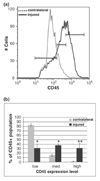Macrophages are comprised of resident brain microglia not infiltrating peripheral monocytes acutely after neonatal stroke
- PMID: 17212701
- PMCID: PMC2262099
- DOI: 10.1111/j.1471-4159.2006.04162.x
Macrophages are comprised of resident brain microglia not infiltrating peripheral monocytes acutely after neonatal stroke
Abstract
Macrophages can be both beneficial and detrimental after CNS injury. We previously showed rapid accumulation of macrophages in injured immature brain acutely after ischemia-reperfusion. To determine whether these macrophages are microglia or invading monocytes, we subjected post-natal day 7 (P7) rats to transient 3 h middle cerebral artery (MCA) occlusion and used flow cytometry at 24 and 48 h post-reperfusion to distinguish invading monocytes (CD45high/CD11b+) from microglia (CD45low/medium/CD11b+). Inflammatory cytokines and chemokines were determined in plasma, injured and contralateral tissue 1-24 h post-reperfusion using ELISA-based cytokine multiplex assays. At 24 h, the number of CD45+/CD11b+ cells increased 3-fold in injured compared to uninjured brain tissue and CD45 expression shifted from low to medium with less than 10% of the population expressing CD45high. MCA occlusion induced rapid and transient asynchronous increases in the pro-inflammatory cytokine IL-beta and chemokines cytokine-induced neutrophil chemoattractant protein 1 (CINC-1) and monocyte-chemoattractant protein 1 (MCP-1), first in systemic circulation and then in injured brain. Double immunofluorescence with cell-type specific markers showed that multiple cell types in the injured brain produce MCP-1. Our findings show that despite profound increases in MCP-1 in injured regions, monocyte infiltration is low and the majority of macrophages in acutely injured regions are microglia.
Figures





References
-
- Allan SM, Tyrrell PJ, Rothwell NJ. Interleukin-1 and neuronal injury. Nat Rev. Immunol. 2005;5:629–640. - PubMed
-
- Anthony DC, Bolton SJ, Fearn S, Perry VH. Age-related effects of interleukin-1 beta on polymorphonuclear neutrophil-dependent increases in blood–brain barrier permeability in rats. Brain. 1997;120:435–444. - PubMed
-
- Anthony D, Dempster R, Fearn S, Clements J, Wells G, Perry VH, Walker K. CXC chemokines generate age-related increases in neutrophil-mediated brain inflammation and blood–brain barrier breakdown. Curr. Biol. 1998;8:923–926. - PubMed
-
- Arvin KL, Du Han BHY, Lin SZ, Paul SM, Holtzman DM. Minocycline markedly protects the neonatal brain against hypoxic-ischemic injury. Ann. Neurol. 2002;52:54–61. - PubMed
-
- Back SA, Rivkees SA. Emerging concepts in periventricular white matter injury. Semin. Perinatol. 2004;28:405–414. - PubMed
Publication types
MeSH terms
Substances
Grants and funding
LinkOut - more resources
Full Text Sources
Medical
Research Materials
Miscellaneous

